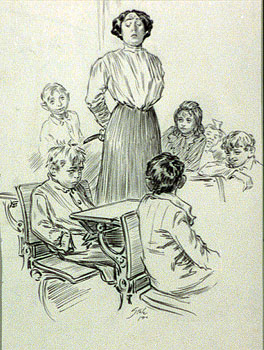Discipline continued
Keeping students 'in line' and focused on their studies was the primary goal of most teachers. Children were often reprimanded if they didn't obey the rules. "Sparing the rod meant spoiling the child" was both household and classroom psychology. The hickory stick doubled as a pointer and as a tool for punishing those who misbehaved.
It was common for students to be struck across the hand with a ruler if they were disruptive. Fortunately the early ruler, called a ferula, was a very light, flat, flexible piece of wood. Today such practices, known as corporal punishment, are illegal in many states.
It is said that girls were spanked less often than boys. An unruly student, regardless of gender, might have been made to sit in the corner with a dunce's hat on their head, more embarrassing than anything.
In many schools great attention was paid to polite behavior. Often girls would curtsy and boys would bow as their teacher entered or left the classroom. It was common for the teacher to remind students at the end of the day to remember to show their manners to their parents at home.

Library of Congress Frederic C. Dorr